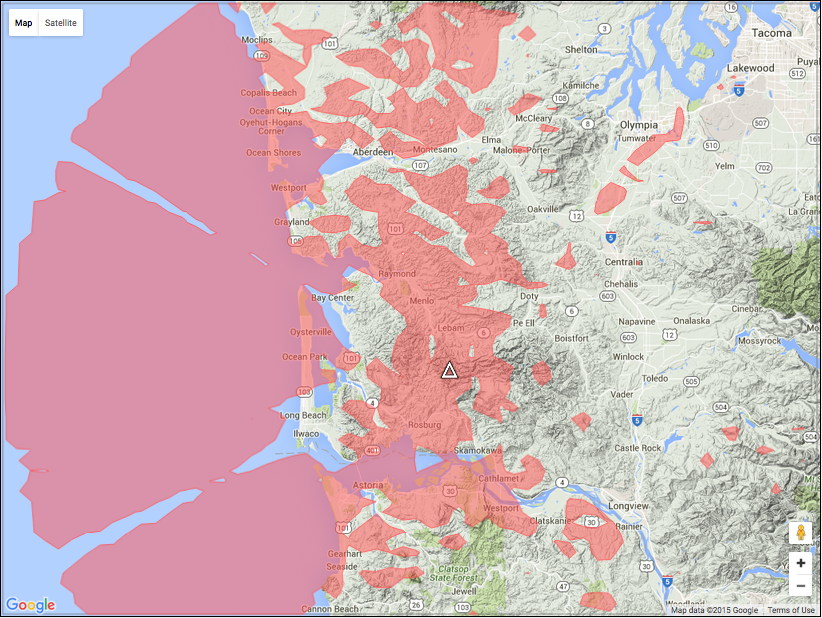KO Peak
Pacific County, WA
46.461068, -123.550658
2900 Feet
Call: N7XAC
441.675 +5MHz 118.8Hz

KO Peak UHF Repeater
|
Location: KO Peak is the highest radio site in Pacific County, and
is located 6 miles south of Lebam, WA. It is 12 miles by logging road
from the highway, and can be inaccessible much of the year due to
lingering snow because the road climbs the northern face of the mountain
and much of the road is in shadow nearly all the time.
Coverage: KO Peak is a great long-range site, and both repeaters
can be worked directly from Tacoma, Olympia and northern Grays Harbor County
on the north; Vancouver, WA, and Seaside, OR on the south and well out to sea
to the west. The intra-county coverage within Pacific County can be spotty, with
some very good locations and some not so good. The "KO" repeaters are
very strong in the Willapa
Valley, and northern Pacific County, as well as portions of Grays Harbor
County, along the Interstate-5 corridor, and on the Long Beach Peninsula.
Click here for a site plot for the UHF machine,
but representative of the coverage from both repeaters, with the 224.040
being moderately better.
The KO Peak site is instrumental in conjunction with the
BeachNet
linking system to knit the network together. The UHF and VHF repeaters
each have their role, and both can be accessed directly from the
Washington State Emergency Coordination Center at Camp Murray. This is a
keystone of the Pacific County ARES/RACES Emergency Plan.
Click here for information on the VHF
224.040 MHz repeater.
The 441.675 repeater normally operates linked as part of the
BeachNet
system of repeaters, with primary coverage in the Willapa Valley, and
extensive areas of Pacific, Grays Harbor, Wahkiakum, Clatsop
and Lewis Counties. The UHF repeater can be worked from Vancouver, WA,
on the south, to Tacoma on the north. Although the terrain produces many
shadowed dead spots around the region, the KO Peak UHF repeater can be
useable from a surprising number of locations.
The KO Peak UHF repeater incorporates a remote base station,
allowing frequency agile use of the FM portions of the 10-, 6-, 2-,
and 1.25-meter,
and 70-centimeter bands. This is available for communications with
other repeaters or on simplex frequencies, with a very favorable range
afforded by the 3000-foot altitude of the antennas. The entire network
is normally connected together, and shares these flexible links.
The repeater system controller uses the remote base station to
provide the automatic links to other systems for nets and other
special activities.
The remote base station
can be controlled from any repeater in the network by any of
the system Control Operators. If you have a need to make
such a contact, direct your request to a Control Operator.
The KO Peak station took
a direct lightning strike
on November 7, 2009,
vaporizing the
UHF antenna,
damaging the
nearby 220-MHz antenna,
and taking out the
circulator, preamp, and
power supply.
To make matters worse,
the site was inaccessible
under deep snow.
This is arguably the
"worst case
scenario"
as far as a repeater
station on a high,
remote site.
Fortunately, the
site structures and
our equipment were
properly grounded.
The remainder of the
station survived.
Thanks to our loyal
users, contributing
in support of network
maintenance,
spares were on
hand to
replace the
destroyed components.
The UHF station was
back on the air
by December.
The 220 antenna
was replaced in May, 2010.
Hardware: The UHF station consists of a GE Mastr-II
110-watt continuous duty
base station with the output routed
through a circulator, low-pass filter,
and a Phelps-Dodge
6-cavity bandpass-notch duplexer to
a "Stationmaster" style gain
vertical at the top of the
tower through 100-feet of LDF5-50 7/8-inch hardline. The controller is an
ACC RC-850 with Digital Voice Recorder and an FC-900 interface for the remote
base. The 140-, 220- and 440-MHz remote base radios share a Comet
CX-333 tri-band antenna forty-feet up the tower
through a triplexer, while the 6-meter radio uses a ground-plane vertical
on the fence and the 10-meter radio uses a vertical wire
dipole on the side of the tower.
There is a dedicated control receiver and a second, single-channel receiver
that only "presses the reset button" on the controller as a
fail-safe back-up.
|